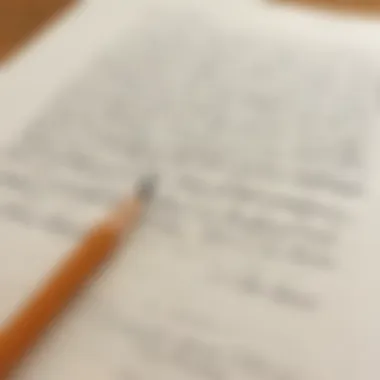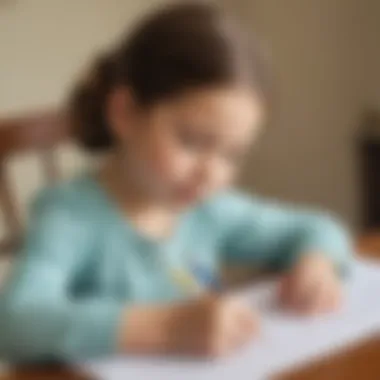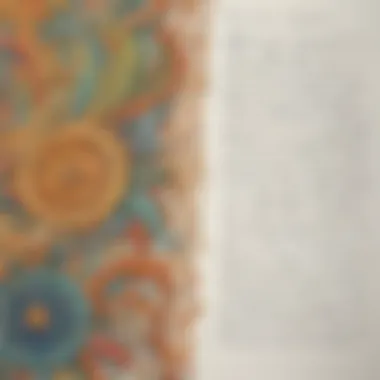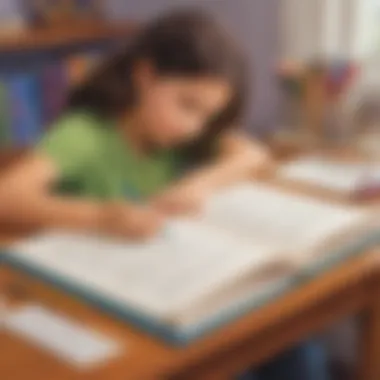Unleashing the Transformative Power of Learning Cursive with Engaging Worksheets


Fun Activities Ideas
When it comes to enhancing handwriting skills through cursive writing, incorporating fun and engaging activities can make the learning process more enjoyable for children. Indoor activities such as creating handwritten letters to friends or family members can improve penmanship and letter formation. Furthermore, practicing cursive outdoors on a chalkboard or with sidewalk chalk adds a dynamic element to learning. Arts and crafts projects involving cursive writing, like personalized bookmarks or greeting cards, can stimulate creativity and dexterity. Additionally, integrating science experiments that require writing observations in cursive can enhance both writing skills and scientific understanding. Finally, involving children in cooking and baking activities where they write out recipes in cursive can combine language practice with practical life skills.
Educational Games
To reinforce cursive writing skills, educational games tailored to incorporate handwriting can be both stimulating and effective for young learners. Math and logic games that involve writing out numbers and equations in cursive can enhance numerical fluency and handwriting proficiency simultaneously. Language and vocabulary games with word tracing or spelling exercises in cursive offer a fun way to reinforce language skills. STEM activities that involve recording scientific data or observations in cursive handwriting can bridge the gap between science and writing. History and geography puzzles that require labeling maps or timelines in cursive can provide a multidisciplinary learning experience. Interactive learning apps specifically designed to practice cursive writing can offer personalized feedback and progress tracking for children.
Seasonal and Holiday Activities
Incorporating cursive writing practice into seasonal and holiday activities can infuse learning with festive themes and excitement. Enhancing Valentine's Day crafts with handwritten messages in cursive adds a personal touch and reinforces handwriting skills. Halloween costume ideas that involve creating name tags or spooky stories in cursive can spark creativity and handwriting practice. Thanksgiving cooking projects where kids write out recipes or menu plans in cursive combine culinary skills with language development. Christmas decorations crafted with cursive lettering, such as ornaments or gift tags, can add a unique flair to holiday celebrations. Setting New Year's resolutions in cursive can encourage goal setting and reflective writing for kids.
Parenting Tips and Resources
Parents play a crucial role in supporting children's cursive writing journey, and incorporating effective parenting tips can make the learning process more successful. Encouraging creativity by providing opportunities for children to express themselves through cursive writing can foster a love for the art of handwriting. Setting up a playful learning environment conducive to cursive practice, with ergonomic writing tools and comfortable workspaces, can enhance children's handwriting experience. Balancing screen time with physical activities that involve cursive writing, such as outdoor play or art projects, promotes holistic development. Building strong family bonds through shared cursive writing projects or letter exchanges can strengthen emotional connections within the family unit. Motivating kids to stay active through engaging cursive writing activities can enhance both physical and cognitive development.
Fun Facts and Trivia
Delving into fun facts and trivia related to cursive writing can stimulate children's interest and curiosity about this timeless skill. Exploring the animal kingdom through handwritten facts about different species in cursive can blend handwriting practice with learning about wildlife. Uncovering the stories behind famous inventions through cursive-written anecdotes can pique children's interest in both history and innovation. Learning about historical events for kids by writing out key dates or facts in cursive can bring history to life in a tangible way. Discovering mythical creatures and legends through cursive-written tales can unleash children's imagination and creativity. Venturing into space adventures and discoveries through cursive writing can inspire a sense of wonder and exploration in young learners.
Introduction
Cursive writing, a timeless art form, holds a crucial role in cognitive development, transcending the mere act of transcription on paper. In this comprehensive guide, we unravel the significance of cursive writing and its transformative impact on the learning process, specifically focusing on how cursive worksheets can elevate children's handwriting skills and overall learning outcomes. By delving into the intricacies of cursive learning, we aim to equip parents, educators, and young learners with the necessary tools to navigate this traditional yet essential skill.
Understanding Cursive Writing
The Art of Handwriting
In exploring the eloquence of cursive penmanship, we uncover the intricate dance between strokes and loops that characterize the art of handwriting. The fluidity and connectivity inherent in cursive allow for a seamless expression of thoughts onto paper, fostering a sense of artistic identity in each stroke. The natural flow of the cursive style enhances not only the aesthetics of writing but also strengthens neural connections related to language processing, making it a prudent choice for honing writing skills.
Cursive vs. Print
Drawing a comparison between cursive and print unveils the distinctive features that set these two writing styles apart. Cursive, with its continuous flow and interconnectedness, promotes a more efficient and expressive mode of writing compared to the disjointed nature of print. The rhythmic movement required in cursive aids in memory retention and cognitive processing, making it a preferred choice for educators focusing on holistic learning approaches. While cursive may pose initial challenges due to its complexity, the cognitive benefits it offers far outweigh the temporary hurdles encountered.
Importance of Cursive Skills


Cognitive Benefits
The cognitive benefits of mastering cursive extend beyond mere penmanship, delving into the realm of enhanced brain connectivity and cognitive functionality. Cursive writing engages multiple areas of the brain simultaneously, fostering improved cognitive processing and memory retention. The intricate hand-eye coordination required in cursive activates neural pathways responsible for higher-order thinking, making it a potent tool for enhancing overall cognitive function.
Academic Advantages
Embracing cursive skills translates into tangible academic advantages, with studies indicating a positive correlation between cursive proficiency and academic performance. The act of writing in cursive enhances reading comprehension and information retention, offering students a unique cognitive edge in the academic sphere. With cursive serving as a catalyst for creative thinking and analytical skills, educators recognize its value in shaping well-rounded learners equipped for academic success.
Overview of Cursive Worksheets
Practical Tools for Learning
Cursive worksheets serve as practical instruments for guiding learners through the intricate art of cursive writing. These structured resources provide a scaffolded approach to mastering cursive, starting from fundamental strokes to complex letter formations. Through repetitive practice facilitated by worksheets, students develop muscle memory and refine motor skills essential for fluid cursive writing. The tactile experience of penning cursive letters on paper enhances kinesthetic learning, making worksheets an indispensable tool for cursive proficiency.
Structuring the Practice
Effective cursive practice hinges on the strategic structuring of learning activities within worksheets. By delineating clear practice guidelines and progress tracks, worksheets offer a roadmap for continuous improvement in cursive writing skills. Structured practice sessions foster discipline and consistency, key elements in mastering the art of cursive. Furthermore, the systematic approach embedded in cursive worksheets ensures a gradual but steady progression towards cursive fluency, empowering learners to navigate the challenges of handwriting with confidence.
Benefits of Using Cursive Worksheets
In this section, we delve into the paramount importance of utilizing cursive worksheets as an effective tool for enhancing children's learning outcomes. By incorporating cursive writing exercises, learners can benefit greatly from improved handwriting skills and cognitive development. The utilization of cursive worksheets offers a structured approach that aids in honing essential skills required for academic success.
Enhanced Handwriting Skills
Improving Motor Skills
Enhancing motor skills through cursive writing is a fundamental aspect that directly impacts overall handwriting proficiency. By engaging in activities that focus on improving motor skills, such as precise penmanship and controlled strokes, children can develop refined dexterity and coordination. This targeted practice not only enhances handwriting legibility but also promotes fine motor skill development crucial for various tasks in daily life.
Fostering Muscle Memory
Fostering muscle memory through cursive writing involves repetitive practice that engrains letter formation patterns in the brain. This process reinforces neural pathways associated with handwriting, leading to enhanced recall and automaticity in letter formation. By fostering muscle memory, children can write fluently and effortlessly, reducing cognitive load and enhancing writing fluency.
Cognitive Development
Boosting Brain Connectivity
Engaging in cursive writing facilitates brain connectivity by involving multiple cognitive processes simultaneously. The intricate hand movements required in cursive writing stimulate neural pathways associated with language processing, fine motor skills, and visual recognition. This multisensory involvement enhances synaptic connections in the brain, fostering improved neural plasticity.


Enhancing Focus and Memory
Cursive writing enhances focus and memory by requiring sustained attention and active engagement during the writing process. The continuous flow of cursive strokes promotes concentration and strengthens neural circuits responsible for memory encoding and retrieval. By practicing cursive writing, children can improve their cognitive abilities related to attention span, information retention, and mental processing speed.
Academic Performance
Aiding Reading Comprehension
Cursive writing plays a pivotal role in aiding reading comprehension by enhancing visual recognition and fluency in deciphering written text. The connected nature of cursive letters improves letter recognition speed and promotes word segmentation skills crucial for efficient reading. By mastering cursive writing, students can enhance their overall reading proficiency and comprehension abilities.
Stimulating Creative Thinking
Stimulating creative thinking through cursive writing fosters a deeper connection between language expression and cognitive flexibility. The fluidity of cursive strokes encourages imaginative thinking and expression, allowing students to engage in creative writing activities with enhanced fluency. By integrating cursive writing into academic tasks, educators can inspire students to think critically and express their ideas more creatively.
Strategies for Effective Cursive Learning
In this article, the section on 'Strategies for Effective Cursive Learning' emphasizes the crucial role of implementing sound strategies to enhance cursive writing skills effectively, especially for young learners. Understanding the nuances of cursive writing and the importance of proper techniques play a significant part in improving handwriting abilities and overall cognitive development. The focus is on promoting structured approaches that yield tangible results, guiding children towards mastering the art of cursive writing with proficiency and confidence.
Consistent Practice Techniques
Guided Tracing Exercises:
Guided Tracing Exercises form a fundamental aspect of cursive writing practice, offering a systematic approach to familiarize young learners with cursive letter formations. By providing a scaffolded learning environment, guided tracing exercises assist children in understanding stroke sequences, letter connectivity, and overall letter structure. The structured nature of guided tracing exercises promotes muscle memory development and enhances fine motor skills vital for precise cursive writing. This method stands out for its ability to offer clear visual cues and feedback, facilitating a gradual transition from tracing to independent writing.
Repetitive Drills:
Repetitive Drills are essential in reinforcing cursive writing skills by focusing on consistent repetition of cursive letter patterns and words. Through repetitive drills, children can internalize letter forms, spacing, and directional flow, leading to increased fluency and accuracy in cursive writing. The repetitive nature of drills aids in automating handwriting movements, allowing learners to build expertise and proficiency over time. While repetitive drills can enhance muscle memory and reinforce cursive patterns effectively, it is essential to balance repetition with engaging activities to maintain motivation and interest in the learning process.
Engaging Activities for Kids
Creative Writing Prompts:
Creative Writing Prompts serve as inspiring tools to encourage children to practice cursive writing in a creative and purposeful manner. By providing prompts that spark imagination and storytelling, children can apply their cursive skills in context, fostering language development and creative expression. The interactive nature of creative writing prompts not only strengthens cursive abilities but also nurtures critical thinking and communication skills. Additionally, creative writing prompts offer a fun and engaging way for children to showcase their handwriting skills while honing their creativity and writing proficiency.
Decorative Lettering Projects:


Decorative Lettering Projects enhance the visual appeal of cursive writing practice, combining aesthetics with skill-building exercises. These projects encourage children to experiment with different fonts, styles, and decorative elements, adding a creative dimension to their cursive writing journey. By incorporating artistry into cursive exercises, decorative lettering projects make learning engaging and enjoyable, motivating children to practice and refine their handwriting skills. The incorporation of artistic elements in cursive practice not only improves penmanship but also encourages self-expression and appreciation for the art of handwriting.
Utilizing Technology
Cursive Writing Apps:
Cursive Writing Apps leverage technology to provide interactive and engaging platforms for children to practice and improve their cursive writing skills. These apps offer features such as interactive tracing, personalized feedback, and progress tracking, making cursive learning accessible and engaging for young learners. By integrating multimedia components and gamified elements, cursive writing apps enhance user experience, ensuring efficient skill development and retention. The convenience and accessibility of cursive writing apps make them a valuable tool for complementing traditional learning methods and promoting continuous practice and improvement.
Online Resources:
Online Resources offer a wealth of cursive writing materials, worksheets, tutorials, and activities that cater to diverse learning needs and preferences. From printable worksheets to instructional videos, online resources provide a versatile platform for children to enhance their cursive writing skills independently. The accessibility of online resources allows learners to practice cursive writing anytime, anywhere, promoting self-directed learning and skill mastery. While online resources offer convenience and a vast repository of learning materials, it is essential for parents and educators to curate age-appropriate and educational content to ensure meaningful cursive writing practice and development.
Tips for Parents and Educators
Encouraging Practice at Home
Creating a Supportive Environment
Creating a supportive environment at home is a cornerstone of fostering a positive attitude towards cursive writing. Parents and educators can establish a dedicated workspace that is conducive to learning, free from distractions, and equipped with the necessary tools such as cursive worksheets and pens. By creating a nurturing space, children can feel encouraged and motivated to practice their cursive skills consistently, leading to improved mastery and retention of handwriting techniques.
Incorporating Cursive into Daily Activities
Integrating cursive writing into daily activities is a practical way to reinforce learning beyond structured practice sessions. Encouraging children to write grocery lists, short notes, or even journal entries in cursive can make the practice more engaging and relevant to their daily lives. By seamlessly incorporating cursive into everyday tasks, parents and educators can help children see the practical value of mastering cursive writing, making it a natural and essential skill in their academic and personal development.
Collaboration with Schools
Advocating for Cursive Instruction
Advocating for cursive instruction in schools is vital to ensuring that children are exposed to this valuable skill early on. By emphasizing the cognitive benefits and academic advantages of cursive writing, parents and educators can advocate for its inclusion in school curricula. Collaborating with school administrators and teachers to highlight the role of cursive in enhancing creativity, critical thinking, and fine motor skills can lead to a broader appreciation for the importance of cursive handwriting in today's digital age.
Supplementing School Curriculum
Supplementing school curriculum with additional cursive practice can further reinforce the learning process and deepen students' understanding and proficiency. Parents and educators can introduce supplementary cursive worksheets, workbooks, or online resources to complement classroom instruction. By providing extra practice opportunities, children can hone their cursive skills outside school hours, accelerating their progress and boosting their confidence in mastering this traditional but valuable form of communication.
Monitoring Progress and Celebrating Milestones
Tracking Improvement
Tracking improvement in cursive writing is essential for evaluating the effectiveness of the learning process. Parents and educators can maintain regular assessments of children's handwriting skills, noting areas of improvement and areas that may require additional practice or support. By monitoring progress closely, they can tailor instruction to address individual needs, ensuring steady growth and development in cursive writing proficiency.
Recognizing Achievements
Recognizing and celebrating children's achievements in cursive writing can motivate and inspire continued dedication to learning. By acknowledging milestones such as improved letter formation, increased writing speed, or enhanced readability, parents and educators can instill a sense of pride and accomplishment in young learners. Celebrating achievements, no matter how small, reinforces the value of perseverance and effort in mastering new skills, fostering a positive attitude towards learning and growth.



